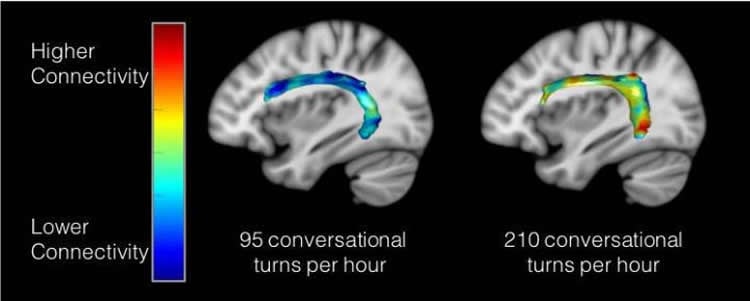Summary: Researchers report the greater conversational turn taking between adults and children, the stronger the connections are between the Wernicke’s area and Broca’s area in the child’s brain.
Source: SfN.
Young children who are regularly engaged in conversation by adults may have stronger connections between two developing brain regions critical for language, according to a study of healthy young children that confirms a hypothesis registered with the Open Science Framework.
This finding, published in Journal of Neuroscience, was independent of parental income and education, suggesting that talking with children from an early age could promote their language skills regardless of their socioeconomic status.
Although decades of research have established a relationship between socioeconomic status and children’s brain development, the specifics of this connection are not known. The so-called “word gap” — the influential finding from the early 1990s that school-age children who grew up in lower-SES households have heard 30 million fewer words than their more affluent classmates — and other evidence demonstrating an influence of early language exposure on later language ability suggests a potential influence of language experience on brain structure.

In their neuroimaging study of 40 four- to six-year-old children and their parents of diverse socioeconomic backgrounds, Rachel Romeo and colleagues found that greater conversational turn-taking (measured over a weekend with an in-home audio recording device) was related to stronger connections between Wernicke’s area and Broca’s area — brain regions critical for the comprehension and production of speech.
Funding: Funding provided by Walton Family Foundation, NIH/National Institute of Child Health and Human Development, Harvard Mind Brain Behavior.
Source: David Barnstone – SfN
Publisher: Organized by NeuroscienceNews.com.
Image Source: NeuroscienceNews.com image credited to Romeo et al., JNeurosci (2018).
Original Research: Abstract for “Language Exposure Relates to Structural Neural Connectivity in Childhood” by Rachel R. Romeo, Joshua Segaran, Julia A. Leonard, Sydney T. Robinson, Martin R. West, Allyson P. Mackey, Anastasia Yendiki, Meredith L. Rowe and John D. E. Gabrieli in Journal of Neuroscience Published August 13 2018.
doi:10.1523/JNEUROSCI.0484-18.2018
[cbtabs][cbtab title=”MLA”]SfN”Adult-Child Conversations Strengthen Language Regions of Developing Brain.” NeuroscienceNews. NeuroscienceNews, 14 August 2018.
<https://neurosciencenews.com/language-adult-child-9698/>.[/cbtab][cbtab title=”APA”]SfN(2018, August 14). Adult-Child Conversations Strengthen Language Regions of Developing Brain. NeuroscienceNews. Retrieved August 14, 2018 from https://neurosciencenews.com/language-adult-child-9698/[/cbtab][cbtab title=”Chicago”]SfN”Adult-Child Conversations Strengthen Language Regions of Developing Brain.” https://neurosciencenews.com/language-adult-child-9698/ (accessed August 14, 2018).[/cbtab][/cbtabs]
Abstract
Language Exposure Relates to Structural Neural Connectivity in Childhood
Neuroscience research has elucidated broad relationships between socioeconomic status (SES) and young children’s brain structure, but there is little mechanistic knowledge about specific environmental factors that are associated with specific variation in brain structure. One environmental factor, early language exposure, predicts children’s linguistic and cognitive skills and later academic achievement, but how language exposure relates to neuroanatomy is unknown. By measuring the real-world language exposure of young children (ages 4-6 years, 27 male/13 female), we confirmed the preregistered hypothesis that greater adult-child conversational experience, independent of SES and the sheer amount of adult speech, is related to stronger, more coherent white matter connectivity in the left arcuate and superior longitudinal fasciculi on average, and specifically near their anterior termination at Broca’s area in left inferior frontal cortex. Fractional anisotropy of significant tract sub-regions mediated the relationship between conversational turns and children’s language skills and indicated a neuroanatomical mechanism underlying the SES “language gap.” Post-hoc whole-brain analyses revealed that language exposure was not related to any other white matter tracts, indicating the specificity of this relationship. Results suggest that the development of dorsal language tracts is environmentally influenced, specifically by early, dialogic interaction. Furthermore, these findings raise the possibility that early intervention programs aiming to ameliorate disadvantages in development due to family SES may focus on increasing children’s conversational exposure in order to capitalize on the early neural plasticity underlying cognitive development.
SIGNIFICANCE STATEMENT
Over the last decade, cognitive neuroscience has highlighted the detrimental impact of disadvantaged backgrounds on young children’s brain structure. However, to intervene effectively, we must know which proximal aspects of the environmental aspects are most strongly related to neural development. The present study finds that young children’s real-world language exposure, and specifically the amount of adult-child conversation, correlates with the strength of connectivity in the left hemisphere white matter pathway connecting two canonical language regions, independent of SES and the sheer volume of adult speech. These findings suggest that early intervention programs aiming to close the achievement gap may focus on increasing children’s conversational exposure in order to capitalize on the early neural plasticity underlying cognitive development.






